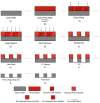Tuning Wetting Properties Through Surface Geometry in the Cassie-Baxter State
- PMID: 39851736
- PMCID: PMC11762741
- DOI: 10.3390/biomimetics10010020
Tuning Wetting Properties Through Surface Geometry in the Cassie-Baxter State
Abstract
Superhydrophobic coatings are beneficial for applications like self-cleaning, anti-corrosion, and drag reduction. In this study, we investigated the impact of surface geometry on the static, dynamic, and sliding contact angles in the Cassie-Baxter state. We used fluoro-silane-treated silicon micro-post patterns fabricated via lithography as model surfaces. By varying the solid fraction (ϕs), edge-to-edge spacing (L), and the shape and arrangement of the micro-posts, we examined how these geometric factors influence wetting behavior. Our results show that the solid fraction is the key factor affecting both dynamic and sliding angles, while changes in shape and arrangement had minimal impact. The Cassie-Baxter model accurately predicted receding angles but struggled to predict advancing angles. These insights can guide the development of coatings with enhanced superhydrophobic properties, tailored to achieve higher contact angles and customized for different environmental conditions.
Keywords: Cassie–Baxter state; contact angle hysteresis (CAH); dynamic wetting; photolithography; silicon micro-posts; superhydrophobicity; surface geometry.
Conflict of interest statement
The authors declare no conflicts of interest.
Figures













Similar articles
-
Objective quantification of surface roughness parameters affecting superhydrophobicity.RSC Adv. 2020 Aug 24;10(52):31251-31260. doi: 10.1039/d0ra03137b. eCollection 2020 Aug 21. RSC Adv. 2020. PMID: 35520686 Free PMC article.
-
Effect of surface texturing on superoleophobicity, contact angle hysteresis, and "robustness".Langmuir. 2012 Oct 23;28(42):14925-34. doi: 10.1021/la302765t. Epub 2012 Oct 10. Langmuir. 2012. PMID: 22992132
-
Drop rebound after impact: the role of the receding contact angle.Langmuir. 2013 Dec 31;29(52):16045-50. doi: 10.1021/la4012372. Epub 2013 Sep 12. Langmuir. 2013. PMID: 24028086
-
Self-Cleaning of Hydrophobic Rough Surfaces by Coalescence-Induced Wetting Transition.Langmuir. 2019 Feb 12;35(6):2431-2442. doi: 10.1021/acs.langmuir.8b03664. Epub 2019 Jan 25. Langmuir. 2019. PMID: 30640480
-
Friction force-based measurements for simultaneous determination of the wetting properties and stability of superhydrophobic surfaces.J Colloid Interface Sci. 2023 Oct 15;648:161-168. doi: 10.1016/j.jcis.2023.05.161. Epub 2023 May 30. J Colloid Interface Sci. 2023. PMID: 37301141
Cited by
-
Demonstration of Pattern Size Effects on Hydrophobic Nanocellulose Coatings with Regular Micron-Sized Island-like Geometrical Domains Created by Femtosecond Laser Micromachining.Micromachines (Basel). 2025 Feb 28;16(3):289. doi: 10.3390/mi16030289. Micromachines (Basel). 2025. PMID: 40141900 Free PMC article.
References
-
- Jeevahan J., Chandrasekaran M., Joseph G.B., Durairaj R.B., Mageshwaran G. Superhydrophobic surfaces: A review on fundamentals, applications, and challenges. J. Coat. Technol. Res. 2018;15:231–250. doi: 10.1007/s11998-017-0011-x. - DOI
-
- Erbil H.Y. The debate on the dependence of apparent contact angles on drop contact area or three-phase contact line: A review. Surf. Sci. Rep. 2014;69:325–365. doi: 10.1016/j.surfrep.2014.09.001. - DOI
-
- Pierce E., Carmona F.J., Amirfazli A. Understanding of sliding and contact angle results in tilted plate experiments. Colloids Surf. A Physicochem. Eng. Asp. 2008;323:73–82. doi: 10.1016/j.colsurfa.2007.09.032. - DOI
LinkOut - more resources
Full Text Sources

